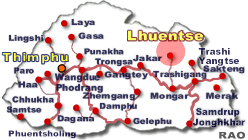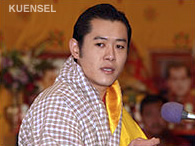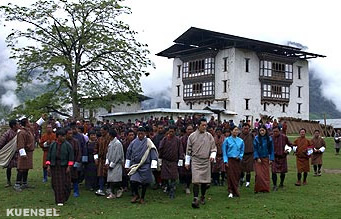| His
Majesty the King Jigme Khesar Namgyel Wangchuck - The 5th Druk Gyalpo |
 |
Bhutan Royal Family The King |
|
 |
Bhutan Royal Family |
|
|
|
|
His
Majesty speaks on Bhutan's future |
 |
 |
| It
was an auspicious moment in history when His Majesty, King Jigme Khesar
entered Dungkar village in Kurtoe, on 21 April 2007.
Along
the lawn of the Jigme Namgyel Nagtshang-home of Jigme Namgyel, father of
the first King of Bhutan- men, women, and children gathered to welcome
His Majesty with warmth and affection. |
|
His
Majesty's visit to Dungkar, Lhuentse, while touring across the eastern
dzongkhags, was to personally witness and encourage villagers participating
in the first ever parliamentary mock election exercise in the nation.
Meeting
with about 568 voters from the 24 villages of Kurtoe gewog, His Majesty
reiterated the importance of people's participation in the democratisation
process.
 |
| the 5th Druk Gyalpo, HM Jigme Khesar Namgyel Wangchuck |
| His
Majesty said, "A strong democratic system will ensure that our people's
aspirations will always be fulfilled. However, as always, whether we are
successful will depend on the commitment and the dignity, people accord
to the process."
|
|
His
Majesty added, "Bhutan is a unique country and our democratic transition
is unique. But unless we work hard, we will not be able to build a strong
democratic system unique to Bhutan, which is what we need."
 |
| His Majesty the King Jigme Khesar Namgyel Wangchuck with the Their Royal
Highnesses Ashi Dechen Yangzom and Ashi Kesang Choden Wangchuck, leading
voters to the polling station. |
| His
Majesty said that the mock election was not so much a test of government
machinery than an effort to further strengthen awareness among the people.
Where villagers seemed hesitant and apprehensive, His Majesty urged them
to seize this opportunity to play their part in a historic moment in Bhutan.
|
|
His
Majesty said that they must learn their roles and responsibilities and
become confident in their ability to make the right choices and decisions
during the coming parliamentary elections.
"We
are still learning the process so we are fortunate to have His Majesty
guide us," a 60-year old Minjur Dema of Dungkar village said.
"Until
now I had been thinking that I have got nothing to do with the 2008 elections.
But seeing His Majesty's personal concern, I realize that it is important
for everyone of us to participate and I will try my best to learn the procedure,"
said Kencho Tseten, 69.
 |
| In
general the people of Dungkar said that they were deeply touched and grateful
for His Majesty's words of encouragement and assurance. "When His Majesty,
who himself is a great patron, advised us on choosing the right leaders,
then I think the new system of government is really our benefit," said
Phuntsho Tshewang, 63, of Jatsabi. "His Majesty's guidance would serve
as a tool to elect the right leaders that would benefit both the country
and the people during the real elections in 2008," said farmer Tshering,
68.
|
|
While
in Dungkar, His Majesty visited both the Jigme Namgyel Nagtshang, which
is under renovation, and also the Dungkar Nagtshang.
"We
did not even dream that His Majesty, who was accompanied by Their Royal
Highnesses Princesses Ashi Dechen Yangzom Wangchuck and Ashi Kesang Choden
Wangchuck, would visit Dungkar. In my lifetime, I feel blessed for getting
the opportunity to see three successive Kings," Karma Lhajey, 49, from
Jatsabi village said.
top
|
Dungkar:
A history |
 |
Dungkar,
the northern-most village of Kurtoe, has long been renowned not only as
the birth place of Bhutan's royal family but as a land blessed by Guru
Rimpoche, and the site of several nyes (sacred places) such as Rinchen
Bumpa and Belyul Khenpajong. According to Lam Neten of Lhuenste Rabdey,
history has it that Guru Rimpoche meditated in a Dra-phu (meditation cave)
on the face of a steep cliff overlooking Dungkar- what we now know as Rinchen
Bumpa - from across the Kurichhu river. A little further south, nestled
higher up in the mountains, it is believed that there is a hidden sacred
abode of Guru Rimpoche, which will be revealed at a pre-ordained time,
for the preservation of the Dharma.
Dungkar
was also visited many times by Terton Pemalingpa, the great treasure revealer
of Bhutan, who lived in the 15th century. A lhakhang built by Pemalingpa
on a flat stretch of land near the riverbed of Kurichhu, is known as Goeshog
Pang (meadow resembling the spread wings of an vulture). Goeshog Pang is
one of the most sacred sites in Kurtoe. Pemalingpa also built two sacred
chortens, the renowned Phu-Sangda Chorten and Dha-Jangchub Chorten, and
brought forth a drup-chu (sacred spring) which still flows today from under
a tree near the house of the Dungkar Choejey (hereditary nobles).
The
Dungkar Nagtshang was founded as a centre for the Peling tradition in the
later half of the 16th century by Drekha and Lankha, the twin sons of Pemalingpa's
grandson, Kuenga Gyaltshen. According to legends, the three older brothers
of the twins were approached by the powerful local deity, Aum Wangchen
Zangmo, to establish the centre, opposite her abode, on a ridge shaped
like a Dungkar (conch). Hence the Nagtshang and its surroundings are known
as Dungkar.
In
keeping with the purpose of building the Dungkar Nagtshang, as a centre
of the Peling tradition, rituals dedicated to Goempo Jatsha is performed
even to this day, on the first day of the eleventh lunar month, culminating
in a three-day Tshechu (mask dance festival) from the ninth day to the
eleventh day.
The
dances are all Terchhams (treasure dances), that were once choreographed
by Pemalingpa himself.
The
family members of the Dungkar Nagtshang, being descendants of a great personage
like Pemalingpa, are known as Dungkar Choejey.
Two
prominent sons of the Dungkar Choejey were Pila Goempo Wangyel and his
older brother, Pala Gyaltshen. Pila, who was born in 1782, went to Gangtoe
Goemba to stay with the Gangtoe Trulku Sizhi Namgyel. He led the army of
Zhabdrung Jigme Drakpa when the Zhabdrung and Sungtruel Yeshi Gyaltshen
were in conflict. After living in western Bhutan for several years, he
returned to Dungkar and lived separately at Khetangbi Nagtshang on a hill
overlooking the Dungkar Nagtshang.
Pila
had five sons, one of which was Jigme Namgyel, born in 1825, who became
the dynamic and powerful Trongsa Penlop. Jigme Namgyel successfully led
Bhutanese forces against the British in Dewangiri, and laid the foundation
for the emergence of the Wangchuck dynasty and the start of a new era of
peace and stability in Bhutan after many years of internal strife and conflict.
Khetangbi
Nagtshang was rebuilt and expanded during Jigme Namgyel's time by his sister,
Ashi Tshewang Dem. It has since been known as the Jigme Namgyel Nagtshang
and is looked after, today, by the Lhuentse Rabdey. Religious ceremonies
in keeping with the traditions established in the time of Pila Goenpo Wangyal
and Trongsa Penlop Jigme Namgyel are still being performed to this day.
| Contributed
by Kesang Dema and Rinzin Wangchuk, Bhutan's National Newspaper, April
2007 |
 |
|
March
24, 2008 |
His
Majesty Jigme Singye Wangchuck, the 4th Druk Gyalpo, has initiated Bhutan's
transition to a democratic, constitutional monarchy. |
Elections
2008 |
 |
|
Tashichhodzong |
|





